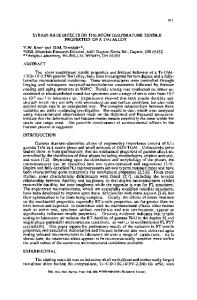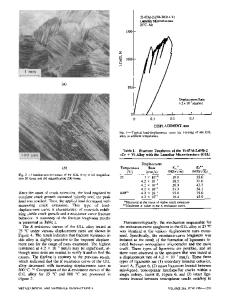Loading Rate Effects and Fracture in a TiAl Alloy
- PDF / 3,088,445 Bytes
- 6 Pages / 420.48 x 639 pts Page_size
- 70 Downloads / 375 Views
LOADING RATE EFFECTS AND FRACTURE IN A TiAl ALLOY
MADAN G. MENDIRAITA, YOUNG-WON KIM* AND DENNIS M. DIMIDUK** *UES, Inc., 4401 Dayton-Xenia Road, Dayton, OH 45432 "**Materials Directorate, WL/MLLM, Wright-Patterson AFB, OH 45433
ABSTRACT The room-temperature fracture toughness and tensile properties were evaluated as a function of loading rate, on a fully lamellar and nearly lamellar y titanium aluminide alloy. The fully lamellar microstructure exhibited increasing toughness with increasing loading rate, however, all other mechanical property data indicated insensitivity to the loading rate. The fracture processes were dominated by translamellar, Mode I separation, and exhibited a process. zone consisting of parallel slip traces/twins leading to formation of microcracks.
INTRODUCTION Numerous studies 11,21 have shown that different thermomechanical processes yield different classes of microstructures in gamma TIAl-based alloys, and these have a strong influence on the balance of mechanical properties. One of the properties which is strongly influenced by the microstructure is the fracture toughness and associated fracture micro-mechanisms and resistance-curve behavior (3,41. The observed degree of toughening in the two phase (7 + ax2 ) alloys has been interpreted within a mechanics analyses of crack tip plastic blunting, large scale crack bridging involving shear ligament formation, and crack deflection
13.41 and crack bridging involving a twinned process zone in the wake of an advancing crack 151. These analyses, however, are based upon the continuum mechanics approach where in local crystallography and its effect on fracture processes are not taken into account. In addition, these studies do not consider the dislocation/twinning plastic processes which occur prior to and may be responsible for crack nucleation. Recent research on polysythetically twinned (PSTJ) y crystals [6,71 has shown a strong influence of crystallographic orientation with respect to the applied stress direction on plastic and fracture processes of the fully lamellar microstructure. Such intrinsically high anisotropy in the flow of single grains is expected to dominate the fracture properties, just as it does in some hcp metals. In previous studies, the reported toughness values of the yThAl alloys have been measured within the range of loading rates permitted by the ASTM Standard. The objective of the present study is to perform a systematic determination of toughness as a function of loading rate encompassing ASTM range as well as
significantly higher rates, and along with this, to understand the fracture micromechanisms of a polycrystalline alloy taking into account the strong plastic and fracture anisotropy exhibited by PST crystals.
Mat. Res. Soc. Symp. Proc. Vol. 288. Q1993 Materials Research Society
544
EXPERIMENTAL PROCEDURE A two-phase yriAl alloy with a nominal composition of TI-48AI-1.6Cr-0.9V2.3Nb (all compositions in atomic percent) was cast using induction skull melting. The casting was hot isostatically pressed at 1200°
Data Loading...











